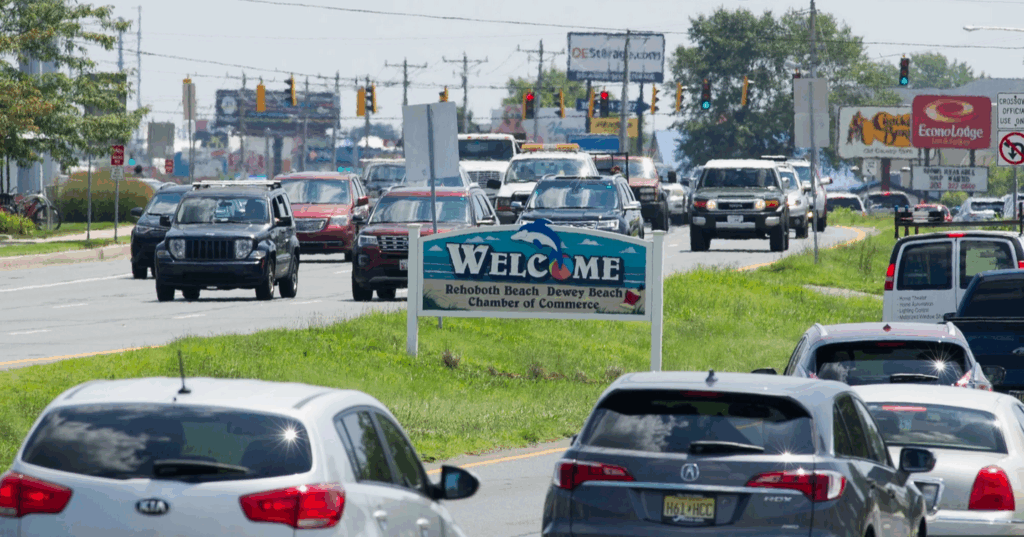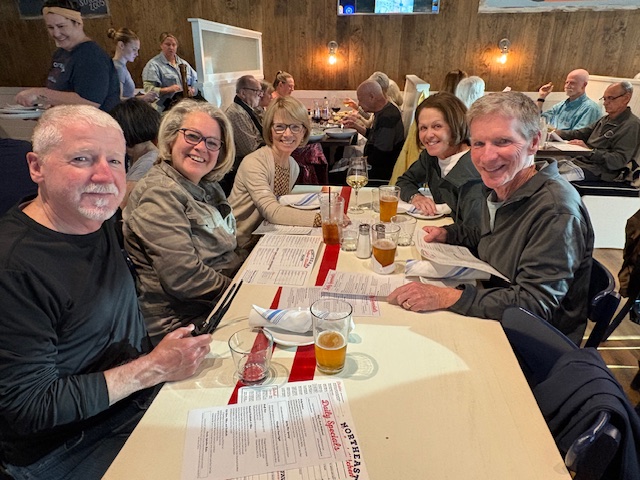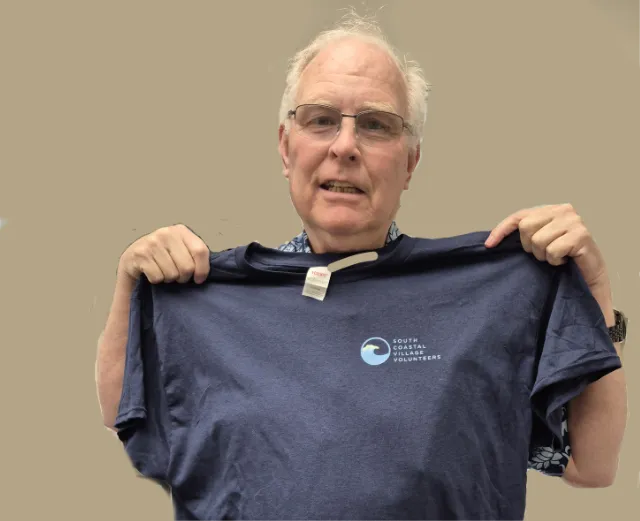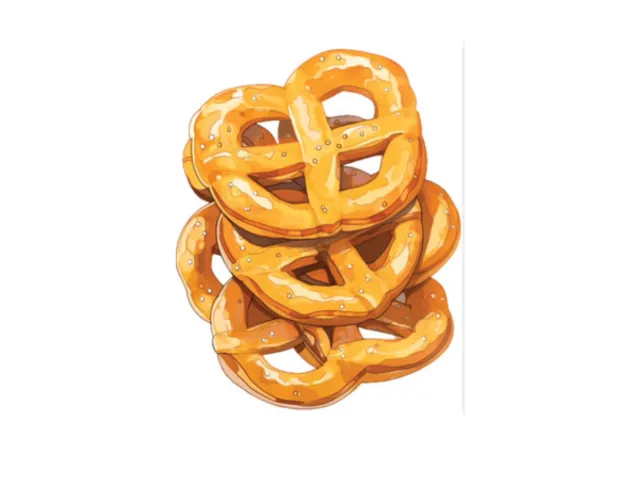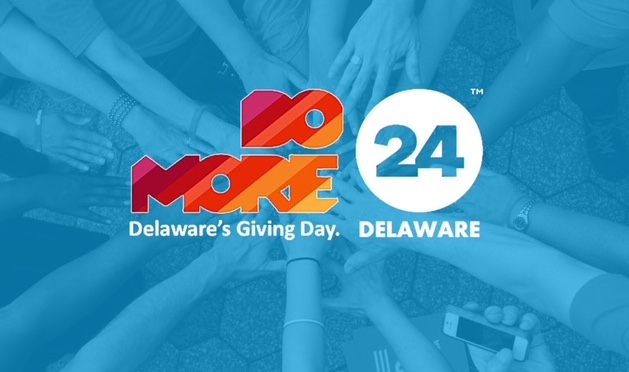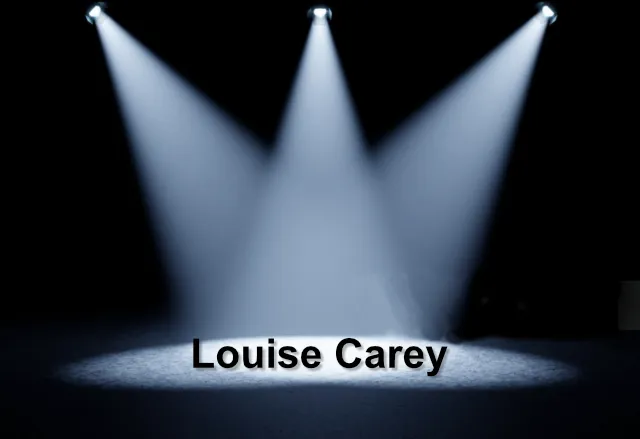
Joan Gordon
“My dream was always to live at the beach,” muses Louise Carey, who celebrated her 99th birthday in early April. Raised in Wilmington, Delaware, Helen Louise Otto spent her summers with her grandmother in Ventnor, New Jersey. Arriving in time for the Atlantic City High School prom and graduation, Louise made many friends with whom she enjoyed her summer days. Starting at her grandmother’s house three blocks from the beach, the group of young people grew as they neared the sand and the ocean, and they spent long days together on the beach. Louise’s love of the beach has never wavered—she has been living only steps from the ocean since 1980.
Louise met Merv Carey while they were both in high school in Wilmington; he was one year ahead of her. After graduation, Merv lied about his age and enlisted in the Marines, serving in the South Pacific during World War II. Louise attended junior college after she graduated. She accepted Merv’s proposal of marriage when he returned from the war, despite his determination to devote the many years of education required for him to become a doctor. They were married in March 1947 and moved to Baltimore.
While Merv was in undergraduate school, Louise worked as secretary to Dr. Gerhard Dieke, head of the Johns Hopkins University Physics Department. In this position, she had clearance for confidential correspondence about the atomic bomb tests being supervised in Los Alamos, New Mexico. Louise also spent her lunch hours typing theses for physics majors, charging by the page. In addition, some of the science professors gave course reviews before exam time, and Louise would sit in and take notes so students could play outdoors on campus; then they paid her for the notes so they could use them to study. Louise also worked at the Johns Hopkins registrar’s office.
Louise and Merv started their family while Merv was still in medical school. Their four children—boys the oldest and the youngest, with two girls in the middle—are now 65, 66, 67, and 70. The Careys lived in a one-bedroom apartment, so Louise and Merv slept on a Murphy bed in the living room while the babies slept in the bedroom. Because money was tight, frequently the entire family would go to the doctors’ dining room at Hopkins, where Merv would fill his tray with as much food as possible and feed the family dinner.
Once Merv was offered a position in an OB-GYN practice at Hopkins, the family stayed in Baltimore. As the children grew older, Louise took the opportunity to spend some time socializing with various groups and playing tennis. “It seems to me like I always played,” she reminisces.
Louise also loved to read and knit. A talented knitter, she traded handknit sweaters for professional courtesy in medical treatments for her family—a novel barter system. As busy as Louise was with four young children, she was enlisted to help out one day as a receptionist in Merv’s office on an emergency basis. She did such a good job that she was hired to stay on as a regular. The Baltimore years were busy, fulfilling, and happy ones.
After renting a house at the Delaware shore for a number of years, the Careys decided to build a home in Cotton Patch Hills in 1978. They moved to Sussex County in 1980, when Merv joined a practice at Beebe Hospital, where he worked for four years. In his retirement, he became a member of the Bethany Beach Volunteer Fire Department.
Louise made many friends in the area and had a busy social and volunteer life. She helped with the Friends of the South Coastal Library’s book sales, and she went to occasional Wednesday movie matinees with friends. Louise continued to play tennis at Sea Colony and Bethany Club Tennis well into her eighties.
A widow for a number of years, Louise now has eight grandchildren and ten great-grandchildren. Still an insatiable reader, she continues to read “anything I can get my hands on,” and for many years she has been a member of a book club organized by tennis friends. The other club members are all at least fourteen years younger than Louise and value her participation, as she represents the ideas and experiences of a different generation. Knitting as a hobby has spread to the entire Carey family: all members contribute to projects, regardless of their ability level.
SCVV Member Louise Carey in her natural habitat: steps from the sand and the sea.
Louise met Merv Carey while they were both in high school in Wilmington; he was one year ahead of her. After graduation, Merv lied about his age and enlisted in the Marines, serving in the South Pacific during World War II. Louise attended junior college after she graduated. She accepted Merv’s proposal of marriage when he returned from the war, despite his determination to devote the many years of education required for him to become a doctor. They were married in March 1947 and moved to Baltimore.
While Merv was in undergraduate school, Louise worked as secretary to Dr. Gerhard Dieke, head of the Johns Hopkins University Physics Department. In this position, she had clearance for confidential correspondence about the atomic bomb tests being supervised in Los Alamos, New Mexico. Louise also spent her lunch hours typing theses for physics majors, charging by the page. In addition, some of the science professors gave course reviews before exam time, and Louise would sit in and take notes so students could play outdoors on campus; then they paid her for the notes so they could use them to study. Louise also worked at the Johns Hopkins registrar’s office.
Louise and Merv started their family while Merv was still in medical school. Their four children—boys the oldest and the youngest, with two girls in the middle—are now 65, 66, 67, and 70. The Careys lived in a one-bedroom apartment, so Louise and Merv slept on a Murphy bed in the living room while the babies slept in the bedroom. Because money was tight, frequently the entire family would go to the doctors’ dining room at Hopkins, where Merv would fill his tray with as much food as possible and feed the family dinner.
Once Merv was offered a position in an OB-GYN practice at Hopkins, the family stayed in Baltimore. As the children grew older, Louise took the opportunity to spend some time socializing with various groups and playing tennis. “It seems to me like I always played,” she reminisces.
Louise also loved to read and knit. A talented knitter, she traded handknit sweaters for professional courtesy in medical treatments for her family—a novel barter system. As busy as Louise was with four young children, she was enlisted to help out one day as a receptionist in Merv’s office on an emergency basis. She did such a good job that she was hired to stay on as a regular. The Baltimore years were busy, fulfilling, and happy ones.
After renting a house at the Delaware shore for a number of years, the Careys decided to build a home in Cotton Patch Hills in 1978. They moved to Sussex County in 1980, when Merv joined a practice at Beebe Hospital, where he worked for four years. In his retirement, he became a member of the Bethany Beach Volunteer Fire Department.
Louise made many friends in the area and had a busy social and volunteer life. She helped with the Friends of the South Coastal Library’s book sales, and she went to occasional Wednesday movie matinees with friends. Louise continued to play tennis at Sea Colony and Bethany Club Tennis well into her eighties.
A widow for a number of years, Louise now has eight grandchildren and ten great-grandchildren. Still an insatiable reader, she continues to read “anything I can get my hands on,” and for many years she has been a member of a book club organized by tennis friends. The other club members are all at least fourteen years younger than Louise and value her participation, as she represents the ideas and experiences of a different generation. Knitting as a hobby has spread to the entire Carey family: all members contribute to projects, regardless of their ability level.
SCVV Member Louise Carey in her natural habitat: steps from the sand and the sea.
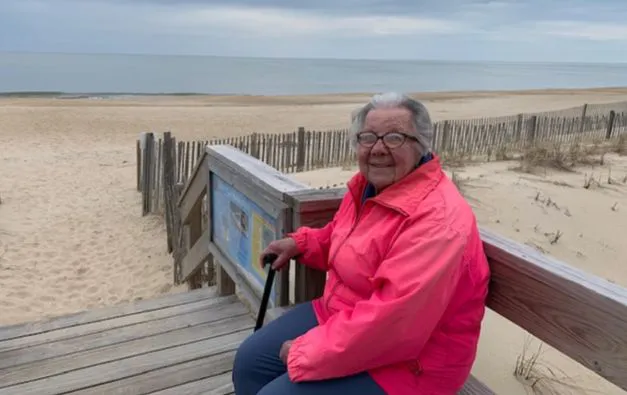
A very independent woman, Louise learned about the South Coastal Village Volunteers from her book club friends and reluctantly became a member in 2021—with the enthusiastic encouragement of her children, who live in Vermont, two far-flung parts of North Carolina, and Georgia. Now that she no longer drives (after a family intervention), Louise sees the village as a “godsend.” As she remarks, the volunteers “couldn’t be more responsive.” She and her children appreciate the daily check-in calls and transportation to various appointments.
Louise, whose dream was living at the beach, says that she “still loves to feel the sand in my shoes.”
Louise, whose dream was living at the beach, says that she “still loves to feel the sand in my shoes.”


